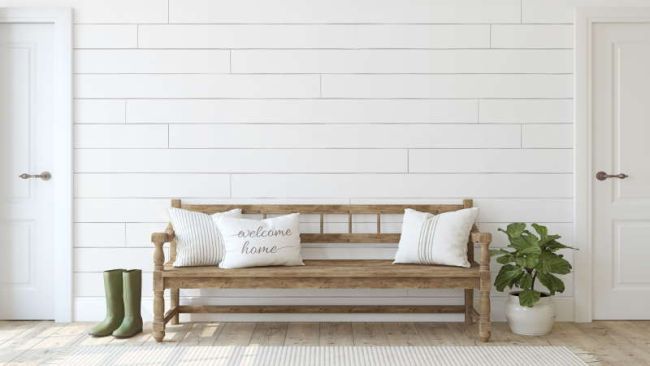
Take 5… Homes with wonderful interiors
Whether you’re renovating your entire house, adding a splash of colour to freshen up the kitchen or looking for inspiration for your new home office, we’ve picked five homes with truly wonderful interiors.


“The tide is turning when it comes to property trends,” says Charlotte Moxon, Head of Regional New Homes at Strutt & Parker. “Where only a couple of years ago, many buyers were hunting for homes with period features – character in the form of mullioned windows, open hearths and original floorboards – today, we’re seeing homes with fresh walls and brand-new fittings increasingly piquing the interest of buyers.”
It’s true, the appetite for a good-quality new build has been growing for a while. Indeed, our most recent Housing Futures survey indicates a shift in desirability to favour new properties, with 48% of buyers aspiring to live in a new-build home. During the post-lockdown boom, statistics saw this demand surge even further, with a 9% rise reported by new-build experts Build Scan. But what is the cause of this dramatic shift in tastes? Are the continually improving standards of new-build homes finally winning us over? Has the prospect of a post-COVID world made us more inclined to shop for practicality over character? And is our love affair with the period property fading to grey?
We ask Charlotte what we can expect from the changing trends.
Looking at the statistics
“According to Housing Futures, last year around one in two buyers said they would prefer to move into a new build rather than existing housing,” says Charlotte. “Now, over a year later, we can see how this trend is being recognised, with new housing developers rushing to meet the rising demand.”
On reviewing the statistics, we can see that the first three months of 2021 had the highest number of new builds constructed in England in over 20 years. Nearly 50,000 new homes were built across the country, a 4% rise from the last three months of 2020. During the first quarter of 2021, builders started on a further 46,010 new-build homes, a 7% rise on the previous quarter.
It’s apparent then, that the appetite for new builds is not only present, but growing, with figures even suggesting some buyers (56%) are willing to move further in order to buy an existing property.
The question now stands, what is driving this trend, and what does it mean for period homes?
Finance and first-time buyers
New-build homes haven’t always been accessible to everyone. In fact, the luxury of brand-new fittings used to be a more expensive property option, requiring a minimum 25% cash deposit on purchase. In recent years however, housing schemes geared toward younger movers have made new builds more affordable – particularly for first-time buyers, who can use the help-to-buy scheme to get their foot on the ladder. In 2019-2020, buyers aged between 25 and 34 made up 41% of homeowners. Meanwhile, 72% of 30-34-year-olds expressed the desire to live in a new build, compared with just 19% of those aged over 66.
“For first-time buyers particularly, new builds just make financial sense,” says Charlotte. “If you’ve been working to scrape together a deposit, and you have the choice of buying a home that’s over 50-years-old or one that’s brand new and comes with a 10 year guarantee, financial security – at least in the short term – clearly points to the latter.”
A matter of convenience
Another undeniable advantage of buying a new-build home is convenience. A new build-home offers a freshly built property, with no previous owners and no hidden damage.
“Young people are busy,” says Charlotte. “The modern lifestyle of a working millennial is high-speed, high-pressure, and that’s without taking into account those with young families. It’s easy to see the attraction of being able to walk into a home where you can paint the walls if you want, you can put some wallpaper up, but you don't need to do anything in order to make it liveable.”
Of course, the benefits of practicality are not wholly isolated to younger demographics. All age groups, from millennials to the over-60s, stand to gain from the ease of owning a new build. Whether you’re a family with young children, looking to dodge the hassle of dramatic renovations, or an older buyer ready to downsize to a home that is easy to take care of, new builds are fast becoming the sensible option, offering purpose-built spaces that require little more than a lick of paint on moving in, if that.
More than just a box
“For today’s buyer, new builds don’t have to be viewed as modern, boring boxes,” says Charlotte. “There are now far more exciting design options out there and for many, that's become a real game changer.”
During the nineties, you would walk along a row of new builds, and everything would look the same. New-build homes had a reputation for being ‘boxes’, featureless and uninspiring in the sense that a buyer could all-but guarantee the layout of any given property before even walking through the door. Now architects, planners and developers of new-build developments are putting more thought and energy into the actual design of the properties, matching them to regional architectural styles on the outside, while in some cases allowing homebuyers to have a say on the design of their interiors.
Community and the environment
With continually improving building standards and environmental regulations, there’s little escaping the fact that new builds are generally far more eco-friendly than period properties.
Everything from the thickness of the walls, to outdated heating systems and less insulation make period properties more expensive and less likely to keep up with environmental standards. Meanwhile, today’s new builds come with features such a cavity wall foam and double glazing, smart meters, and even car charging points, all of which would be a further hassle and added expense to install in an older home. Add to this that two-thirds of millennials consciously look to be as eco-conscious as they can, and it’s easy to see how eco-friendly new builds will continue to rise in popularity.
“Aside from the property itself, we’re also seeing a far greater focus from developers looking to incorporate community spaces, gardens, allotments and even on-site retail units, providing new homes with a wider community feel,” Charlotte says.
“In light of the pandemic, where reliance on communities has become all the more localised, such features could prove an invaluable pull-point for new and future buyers.”
The future of the period home
While the growing appeal of new-build homes is certainly gaining attention among investors and homebuyers alike, Charlotte remains certain that the period property is at little risk of losing its wider appeal.
“I don’t think period properties will ever go out of fashion,” says Charlotte. “Purely because we are so spoilt for choice in the UK with property from various periods of architecture, from the two-up two-down, to the 18th Century thatched cottage, all of which retain features and character that are difficult to replicate in a new home.
“Though new-build properties come with a number of desirable attributes, the same can also be said of the period home. And so, while it’s true the value of new builds is on the rise, this in no way indicates the value of older homes is set to decline.”
As Charlotte points out, changing trends across the housing market do not necessarily come down to a choice between new-build and period homes, but rather a general imbalance between supply and demand.
In a market that has seen pent-up demand as a result of the pandemic, today’s potential homebuyers are faced with a limited choice in what they can buy. There are a number of factors contributing to this, including shifting priorities driving people to relocate, the land transaction tax holidays that encouraged more people to push through with sales, and a nationwide labour and resource shortages (a combined result of Brexit and the pandemic), delaying developments from being finished on time. All resulting in challenges for buyers to find their dream ideal home.
Are you looking to learn more about future housing trends? Download the full Strutt & Parker Housing Futures report online today.